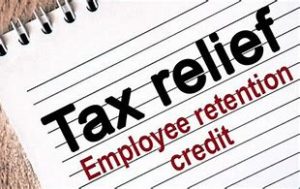The ERTC is encouragement, for employers to keep paying employees, in the form of a refundable credit equal to 50% of up to $10,000 of qualified wages for a maximum $5,000 credit – per employee. The credit is taken against the employer’s share of social security (6.2%). Wages paid after March 12, 2020, and before Jan. 1, 2021, are eligible for the credit.

Eligible.
1. Government Order. Business is fully or partially suspended by government order due to COVID-19 during any 2020 calendar quarter (EVEN IF only one location/entity of more than one location/entity is suspended); OR,
2. Significant Decline in Gross Receipts. 50% less gross receipts than same quarter in 2019. AND eligibility lasts until the quarter AFTER the quarter gross receipts reach 80% of same quarter in 2019.
Not eligible.
1. SBA PPP loan recipients, household employers, and government employers.
2. If self-employed, your wages (self-employment income) is not eligible. Wages paid to your employees are eligible.
Can I take the ERTC if I have (or am taking) …?
SBA PPP Loan – No.
SBA EIDL – Yes.
Paid Sick/Family Leave Credit/FFCRA credits – Yes, BUT NOT for the same wages.
Employer Payroll Tax Deferral – Yes.
Work Opportunity Tax Credit – No.
What are qualified wages?
Qualified wages include both wages and each employer-paid group health care coverage plan including HDHPs, HRAs, and health FSAs. Employer paid health care coverage does NOT include amounts included in employee gross income, HSAs, Archer MSAs, or QSEHRA.
The amount of qualified wages depends upon:
Less than 100 average FTEs in 2019. Wages paid are qualified whether employees provided services or not.
More than 100 average FTEs in 2019. Wages paid are qualified ONLY if employees did NOT provide services. Amounts paid for previously accrued vacation or sick days or holidays are not qualified wages. Wages paid to employees who went from working at the workplace to working from home are NOT qualified wages. All health plan expenses paid on behalf of furloughed employees ARE qualified wages.
FTE – Any employee, who in any month in 2019 worked at least 30 hours a week.
Average FTEs – Add up all the FTEs in every month in 2019 and divide by 12.
How do I claim the Employee Retention Tax Credit?
For immediate cash flow, you can reduce employer tax deposits/payments $5,000 for every $10,000 qualified wages. Remember, you can only reduce the employer 6.2% portion of FICA/Social Security. We have noted no revision to the EFTPS website regarding the ERTC. Include ONLY the employees’ withheld 6.2% on the social security line.
The credit is then claimed and tallied up on the Form 941 for 2020, Employer’s QUARTERLY Federal Tax Return (quarters 2, 3, and 4) as revised April 2020. Of course, there is a little worksheet (Form 941, Worksheet 1) to be completed to figure out what is non-refundable and what is refundable. Remember, the credit can be applied against ONLY the employer 6.2% portion of FICA/Social Security.
If you have more ERTC than 6.2% FICA for the quarter, you can get the remaining ERTC by filing Form 7200, Advance Payment of Employer Credits Due To COVID-19, as revised March 2020.
We recommend each pay period that you record the unpaid/undeposited amount as a debit to expense and a credit to Other Income. If a third-party agent, such as ourselves, or a PEO prepares your payroll and payroll reports and prepares or submits tax deposits on your behalf, IMMEDIATELY get a hold of them and let them know whether or not you want to take advantage of the ERTC. Conversely, IMMEDIATELY get a hold of them should you wish to discontinue taking advantage of the ERTC.
If you need to cancel a previously scheduled EFTPS payment, call 800.555.4477. EFTPS can cancel and reschedule payments. All you have to do is suffer through high call volume and an unusually long wait time and then provide your name and Tax ID number, the exact amount of the payment, and the date of the payment.
It will be important to maintain a system of periodic reconciliation of Form 941 lines 11c and 13d totals to the Other Income account.
For further cash flow maximization, use the Employer Payroll Tax Deferral to defer, if any, the remaining amounts of employer portion 6.2% FICA/Social Security.
Part 2 of 3 – Employer Payroll Tax Deferral – Updated. Part 3 of 3 – Recalling Furloughed Employees.
We are here to guide you through this process and anything else to help you get through COVID-19. Email info@accpas.com. Please put COVID-19 in the subject line. Or call us at 727-327-1999.
In addition to the monthly newsletter and weekly blog we will be sending COVID-19 updates through “Email Updates”.
Follow McAtee & Associates on your preferred social media for additional COVID-19 updates. We are on Facebook, Twitter, LinkedIn, and Google+.
Stay safe. Stay strong!
COVID-19 Disclaimer. Laws and regulations have quickly changed and will continue to change in order to mitigate the economic damage caused by the Coronavirus Crisis. New laws and regulations are being passed quicker than the legislative process has taken in the past. Guidance, clarifications, and interpretations are constantly evolving. Deadlines and due dates are being extended and re-extended. New relief and programs are constantly rising up. This is occurring on all levels: Federal, State, and Local. Information we publish may not be updated after initial publication/dissemination. We are committed to giving you the best answer possible based on what we know at the time your question is asked.
